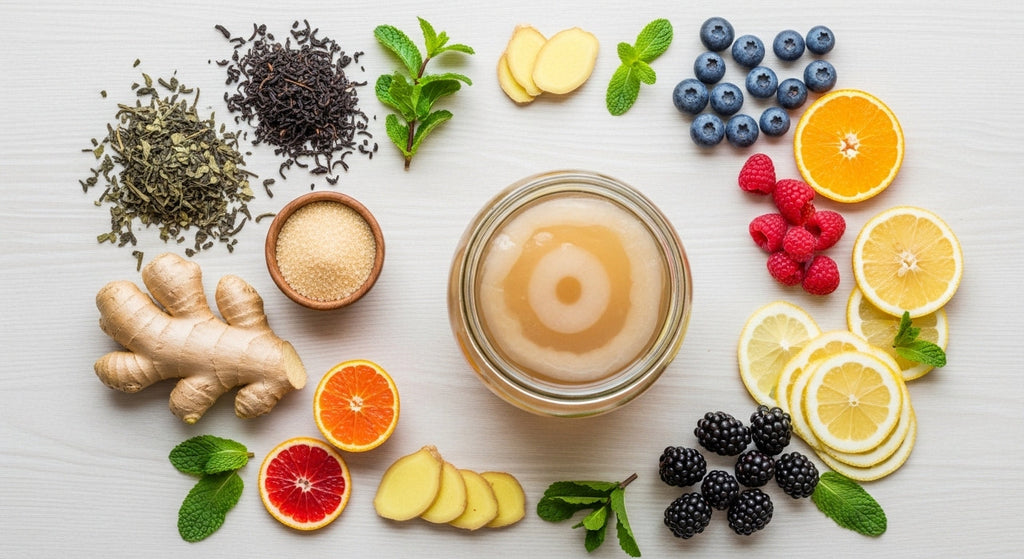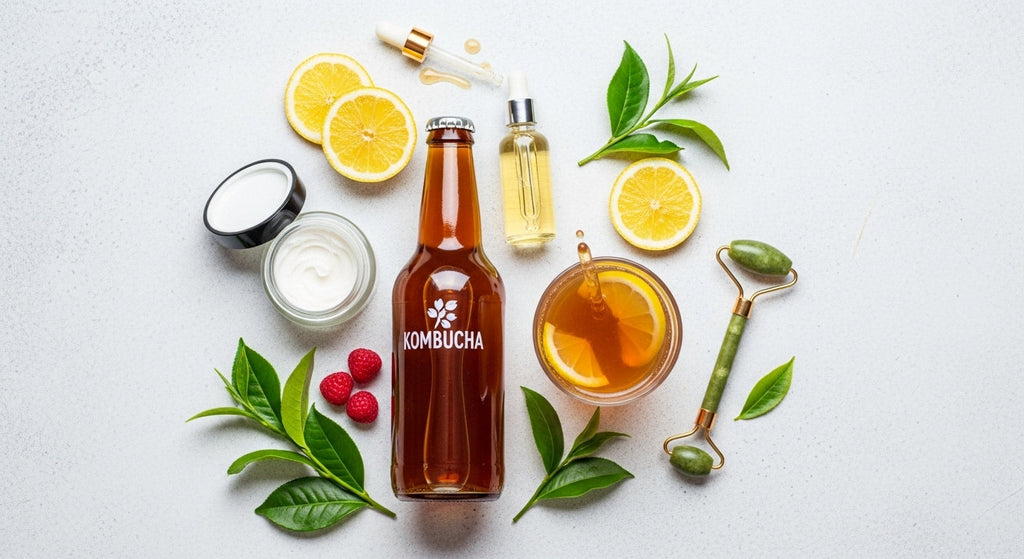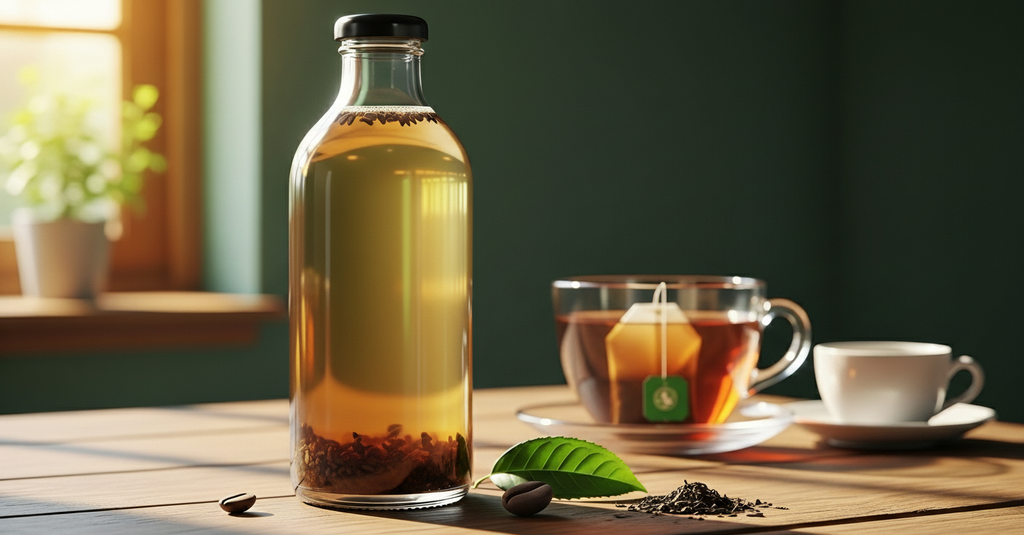
Kombucha Ingredients: Fermented Tea Basics and Benefits

Kombucha Ingredients: Fermented Tea Basics and Benefits
Kombucha is a tangy, slightly fizzy drink made by fermenting sweet tea with the help of a living culture known as a SCOBY — short for Symbiotic Culture Of Bacteria and Yeast. The process starts with boiling water, steeping tea (black, green, or oolong), and mixing in sugar. Once cooled, the tea is combined with some starter kombucha and the SCOBY. Over the course of 7 to 14 days, yeast from the SCOBY consumes the sugar, producing alcohol and carbon dioxide. Meanwhile, bacteria in the SCOBY convert that alcohol into acetic acid and other organic acids, resulting in a complex, probiotic-rich beverage.
A jar of fermenting kombucha typically shows the SCOBY floating on top — a cellulose mat formed by bacteria. The yeast (like Saccharomyces) feed on the sugar to create CO₂ and alcohol, and the bacteria (like Gluconacetobacter) turn that alcohol into acids such as acetic and gluconic acid. This biological teamwork gives kombucha its signature sour taste and gentle fizz.
Key Ingredients and What They Do
Water
The foundational ingredient. It’s essential to use non-chlorinated water, as chlorine can harm the beneficial microbes. Water acts as the medium in which tea compounds are extracted and fermentation takes place.
Tea (Camellia sinensis)
The tea — black, green, or oolong — adds not only flavor and color but also polyphenols, which are powerful antioxidants. Green tea typically offers the highest polyphenol content (like EGCG), contributing extra antioxidant benefits to kombucha.
Sugar (Sucrose)
Regular cane sugar is most often used. It fuels the fermentation process by feeding the microbes. Yeast break sucrose into glucose and fructose, while bacteria later consume the alcohol created. Although most sugar is metabolized, a bit remains to balance the drink’s tartness.
SCOBY (Yeast + Bacteria)
Often referred to as the "tea fungus," the SCOBY is the engine behind kombucha fermentation. Yeasts in the SCOBY (such as Saccharomyces and Brettanomyces) produce alcohol and CO₂, while acetic acid bacteria (Gluconacetobacter, for instance) generate organic acids and form the SCOBY mat. Without the SCOBY, the tea wouldn’t ferment into kombucha.
Starter Tea
This is a bit of kombucha from a previous batch. It helps kickstart the fermentation and immediately lowers the pH to discourage harmful microbes. It also introduces active cultures into the mix.
Flavor Additions (Optional)
After the main fermentation, brewers often add fruits, herbs, or spices to personalize flavor. Popular choices include ginger, citrus, berries, and herbs like basil or mint. These not only enhance taste but add a touch of nutrients or antioxidants. For instance, Dad’s Hack kombucha flavors include ginger & lime, strawberries & basil, hibiscus & rose, and apple & cinnamon.
How Each Ingredient Works Together?
The sugar and tea provide fuel and nutrients for the culture, while the SCOBY’s microorganisms (yeasts and bacteria) transform them into a fermented drink. The yeast convert sugar into ethanol and CO₂, and in the process generate some B vitamins. The acetic acid bacteria then oxidize the ethanol into acetic acid (vinegar) and other acids. The tea’s polyphenols help protect the brew and lend antioxidants. The resulting blend of acids (acetic, gluconic, lactic, etc.), antioxidants, vitamins and live cultures gives kombucha its characteristic taste and potential healthful properties.
Fermentation stages: Jars of kombucha at different stages, each with the SCOBY developing on top. The symbiotic culture turns sweet tea into kombucha by producing acids (like acetic acid) and probiotics. For instance, the predominant bacteria (Gluconacetobacter spp.) oxidize yeast-produced alcohol into acetic acid, creating kombucha’s vinegar-like tang. These acids (plus tea’s own antioxidants) help inhibit unwanted microbes – studies show kombucha’s acetic acid and tea polyphenols can suppress harmful bacteria and yeasts, while leaving the beneficial kombucha microbes intact.
Nutrients and Benefits from Kombucha
Because kombucha starts as tea and sugar, the fermented brew contains a mix of nutrients from both the ingredients and the fermentation. Key components found in kombucha include: Tea polyphenols (from the tea leaves), B vitamins (synthesized by yeast during fermentation), and organic acids like acetic acid and gluconic acid. These combine with the live cultures to give kombucha its health profile. For example, drinking kombucha delivers antioxidants from the tea, as well as probiotic bacteria – it “has been fermented, making it a good source of probiotics. The organic acids (especially acetic acid) act as mild preservatives and have antimicrobial properties; in lab studies they killed or inhibited pathogens, much like vinegar does. The B vitamins (like folic acid) produced by the yeast contribute extra nutrition.
In short, kombucha harnesses synergy: the tea provides plant antioxidants and caffeine, the sugar feeds the culture, and the culture produces acids, carbonation and vitamins. The result is a drink rich in antioxidants, organic acids, and live microbes. (Note: while many health claims are made, scientific evidence is still emerging. Kombucha is generally seen as a refreshing, probiotic-rich beverage rather than a medical cure.)
For more convenience, you can buy kombucha online or at natural food shops to enjoy these benefits without brewing at home.
Dad’s Hack Flavor Spotlight: Basil
Beyond the core ingredients, brewers often get creative. Take Dad’s Hack Berry Basil Kombucha: basil, a fragrant herb full of antioxidants and vitamin K, gives this version a sweet herbal twist. Basil also boasts antibacterial and anti-inflammatory properties. When combined with berries, ginger, or citrus, it not only elevates the flavor but adds functional benefits like improved digestion and immune support.
Other popular additions include:
-
Ginger: Soothes digestion
-
Cinnamon: A warming spice with antioxidants
-
Hibiscus & Rose: Floral notes and a boost of vitamin C
These ingredients enrich both flavor and health benefits, making each brew unique.
Conclusion
At its heart, kombucha is sweet tea transformed into a fermented, probiotic drink. The essential ingredients — water, tea, sugar, and SCOBY — work in harmony to create something greater than the sum of its parts. As it ferments, the drink develops beneficial acids, probiotics, and B-vitamins. Add-ins like fruit or herbs enhance flavor and functional value.
Whether you're making it at home or picking up a bottle from your local market, understanding what goes into kombucha helps you appreciate its complex character. Try out different flavors — from spicy ginger-lime to floral hibiscus — and find your favorite probiotic blend.




